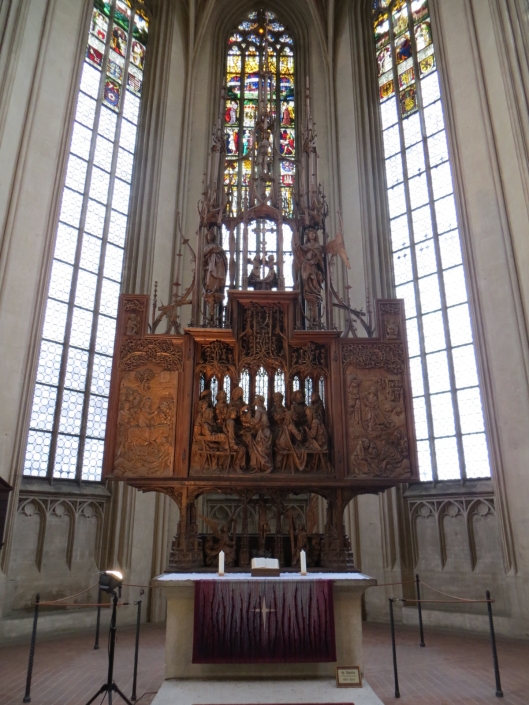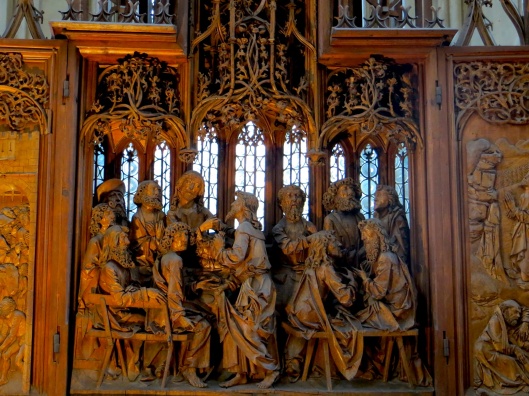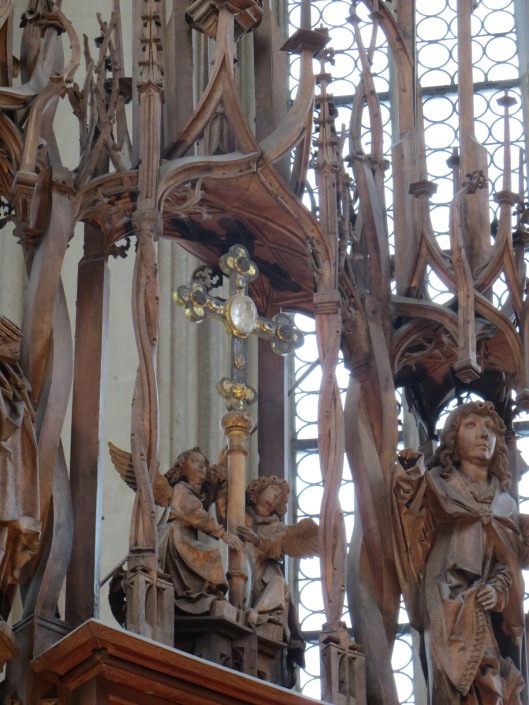Tags
Altar of the Holy Blood, altarpiece, blood relic, Germany, Judas, pilgrimage, reliquary, Rothenburg, Saint James, Santiago de Compostela, Tilman Riemenschneider

Altar of the Holy Blood, Tilman Riemenscheider, St. Jakobskirche, Rothenburg ob der Tauber, Germany, Limewood (1501-1505). Photo by Reliquarian.
The Altar of the Holy Blood
The Altar of the Holy Blood, located at the church of Saint James (St. Jakobskirche), Rothenburg ob der Tauber, Germany, is named for the rare relic it contains: a small sample of Christ’s blood. The relic, encased in rock crystal, is set in a cross held aloft by two carved angels, enshrined above the corpus (central panel).[1] The altarpiece itself is a masterpiece of woodcarving created by the Würzburg sculptor Tilman Riemenschneider between 1501 and 1505. In the medieval period, the church of Saint James, named for the patron saint of pilgrims, was an important stop on the pilgrimage route to Santiago de Compostela in Spain, and the Holy Blood (Heilig Blut) relic was an object of intense devotion. Today, the Altar of the Holy Blood, as well as the church’s other great altarpiece, the Twelve Apostles Altar, continue to draw visitors to the church of Saint James and the picturesque, medieval town of Rothenburg.
Tilman Riemenschneider

Street view of Rothenburg ob der Tauber, Germany. Photo by Reliquarian.
Tilman Riemenschneider (1460-1531), a sculptor and woodcarver who worked primarily in the prince-bishopric of Würzburg, is considered the “most famous of all German late-Gothic sculptors.”[2] Although little is known of his early life, it is believed that he learned to sculpt while traveling in the Rhineland and Swabia, possibly in the cities of Strasbourg and Ulm. In addition to the Altar of the Holy Blood, other celebrated works by Riemenschneider include the Assumption of the Virgin Altarpiece in the Herrgottskirche, Creglingen, Germany, and the Tomb of Emperor Henry II and Empress Cunigunde in Bamberg Cathedral, Bamberg, Germany.

Altar of the Holy Blood (detail), Tilman Riemenscheider, St. Jakobskirche, Rothenburg ob der Tauber, Germany, Limewood (1501-1505). This central panel of the altar depicts the Last Supper. The central figure here, however, is Judas rather than Jesus. Photo by Reliquarian.
Design of the Altar of the Holy Blood
The central panel of the Altar of the Holy Blood depicts the Last Supper, although the figure of Christ, who is normally portrayed at the center of such scenes, has been supplanted by Judas, the Apostle who would later betray Jesus in the Garden of Gethsemane. In The Limewood Sculptors of Renaissance Germany, 1475-1525, Michael Baxandall writes, “Judas is Riemenschneider’s protagonist, displacing Christ from the centre of the Corpus. . . . The emphasis on poor Judas invites meditation, though its significances are unlikely to be arcane: Judas might, for instance, be taken to stand for the lack of discrimination with which God offers grace.”[3] Citing a sermon from the 1490s by Johannes Pauli, a Franciscan writer, Baxandall observes, “Judas . . . can be a signal of hope to pilgrims poor in spirit.”[4]
The two side panels, or wings, flanking the corpus are carved in low relief and depict two other scenes from Jesus’ life: the Entry into Jerusalem and the Agony in the Garden. Near the central pinnacle of the altarpiece is a carving of the Christ of Mercy, which is approximately 3 feet tall.

Relic of the Holy Blood. The Altar of the Holy Blood (Heilig Blutaltar) is named for the relic it was designed to contain: a small sample of Christ’s blood. The relic is set in the center of the cross above, encased in rock crystal. Photo by Reliquarian.
The relic of the Holy Blood, as mentioned above, is displayed just above the corpus and below the figure of the Christ of Mercy. A contract between Riemenschneider and members of the Rothenburg city council from April 1501 describes how the relic was to be displayed. It states, “[A]bove in the shrine in the Auszug he shall carve in the middle two Angels kneeling opposite each other and holding the Holy Cross, and also above the Cross two gliding Angels . . . ; and at the sides next to the Cross, on the right the image of the Virgin Mary and on the left the Angel Gabriel of the type announcing the angelic greeting to her virgin heart . . . .”[5]

Altar of the Holy Blood, Tilman Riemenscheider, St. Jakobskirche, Rothenburg ob der Tauber, Germany, Limewood (1501-1505). Photo by Reliquarian.
A Monochrome Altarpiece
Unusual for this time period, the Altar of the Holy Blood is not gilded or painted. Rather, the wood has been left in its natural state, unfinished. Some sources have argued that Riemenschneider eschewed paint because he preferred the natural beauty of wood.[6] Alternatively, the altarpiece may have remained unpainted because it would have cost too much to paint. Julien Chapuis of the Department of Medieval Art and The Cloisters at the Metropolitan Museum of Art notes, “Retables were costly undertakings that often resulted from the collaboration of several individuals: a sculptor, a joiner, an ironmonger, and, in the case of a polychrome altarpiece, a painter.”[7] The Altar of the Holy Blood, meanwhile, was relatively inexpensive. Baxandall observes, “The sculpture is cheap, monochrome, narrative work . . . . It was very inexpensive work indeed, Riemenschneider being paid sixty Florins for the sculpture, Harschner fifty Florins for the shrinework, very little for a quite large retable in an important station . . . .”
Baxandall suggests that the absence of color “makes for a degree of alienation” and discourages “personal participation” and the “empathetic relation” one may feel toward other works.[8] He states, “The monochrome medium is like black-and-white engraving in that it declares itself as a convention, not fully identifiable with the actual person or event.”[9] In Baxandall’s opinion, the “altarpiece complements rather than abets the kind of pious attention aroused by a relic of the Holy Blood, for Riemenschneider is carving, to use Zwingli’s term, in Geschichteswyß, in a narrative way.”[10]
An Immersive Experience
Nevertheless, the opportunity to see an altarpiece in situ, especially one as significant as the Altar of the Holy Blood with its prized relic, is rare and should not be undervalued.[11] As Chapuis observes, “very few carved altarpieces have survived intact” despite their ubiquity in the late 15th and early 16th century in Central Europe.[12] “The destruction of religious images during the Protestant Reformation, along with neglect, changes in taste, fire, and the secularization of ecclesiastic institutions account for this loss,” he explains. “Many figures and reliefs in museum collections are merely fragments of elaborate, monstrance-like structures, which served as a focus for liturgy, veneration, and pilgrimage.”[13]
[1] See generally Julien Chapuis, Late Medieval German Sculpture: Images for the Cult and for Private Devotion, The Metropolitan Museum of Art, http://www.metmuseum.org/toah/hd/grmn_4/hd_grmn_4.htm (describing the four main elements of an altarpiece).
[2] Tilman Riemenschneider, Encyclopedia of World Biography (2004), available at http://www.encyclopedia.com/topic/Tilman_Riemenschneider.aspx.
[3] Michael Baxandall, The Limewood Sculptors of Renaissance Germany, 1475-1525, at 179 (1980).
[4] Id. at 180.
[5] Baxandall, supra note 3, at 174.
[6] See, e.g., “The Reredos IV: The German World – Tilman Riemenschneider,” The Society of St. Hugh of Cluny (Nov. 16, 2009), http://sthughofcluny.org/2009/11/the-reredos-iv-the-german-world-tilman-riemenschneider.html (“He was one of the German carvers of altarpieces to leave the carvings in the natural wood and abandon the gilt and painted surfaces of tradition.”); Encyclopedia of World Biography, supra note 2 (“Sensing the beauty of the wood itself, Riemenschneider frequently did not polychrome his altarpieces, a novelty at this time.”).
[7] Chapuis, supra note 1.
[8] Baxandall, supra note 3, at 186.
[9] Id.
[10] Id.
[11] See, e.g., Karen Rosenberg, At the Altar of Renaissance Tuscany, NY Times, February 14, 2013, at C32, available at http://www.nytimes.com/2013/02/15/arts/design/piero-della-francesca-in-america-at-the-frick.html?_r=0 (explaining how difficult it can be to “recreate the immersive experience” of a church setting).
[12] Chapuis, supra note 1.
[13] Id.


Pingback: While We are Waiting | 20Time Wood Project
Pingback: Rothenburg ob der Tauber - The Incredibly Long Journey